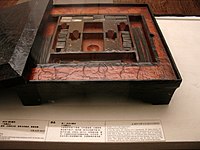Liubo
It is not known when the game of liubo originated, although according to legend it was invented by Wu Cao (烏曹, called Wu Zhou 烏胄 in the early 2nd century CE Shuowen Jiezi dictionary), a minister to King Jie, the last king of the Xia dynasty, who according to traditional chronology reigned 1728–1675 BCE.
[2] The game of liubo is also described in the mid 3rd century BCE poem "Summons of the Soul" ("Zhao Hun" 招魂) in the Songs of Chu: 菎蔽象棋,有六簙些。 分曹並進,遒相迫些。 成梟而牟,呼五白些。 Then with bamboo dice and ivory pieces the game of Liu Bo is begun; Sides are taken; they advance together; keenly they threaten each other.
[4] The game reached its greatest popularity during the Han dynasty, as is evidenced by the discovery of many examples of Liubo boards or sets of Liubo game pieces as grave goods in high status tombs dating to the Han dynasty.
Pottery or wooden figurines of players with model Liubo boards have also been discovered in some Han tombs.
[5][6] Engraved picture stones (畫像石) and moulded picture bricks (畫像磚) that were widely used to decorate tombs and temples during the Eastern Han period (25–220 CE) also frequently depict people playing Liubo, sometimes as a small part of a complex scene depicting many different activities, but sometimes as the focal point of the scene, with the players attended by servants and playing in the cool of a pavilion.
Some picture stones and engravings on stone coffins, especially those from the area of modern Sichuan and Yunnan provinces, show two winged immortals playing Liubo on a mountain, usually as part of a larger scene depicting the Queen Mother of the West and various mythical animals.
Liubo boards and game equipment are often found as grave goods in tombs from the Han dynasty.
Some of the boards are simple square slabs of stone or wood, but others are supported by knobs at the four corners, and some are built as tables with long legs.
However, in 1973 a unique, complete set of Liubo equipment in a lacquer box was discovered in a 2nd-century BCE tomb at Mawangdui (believed to be that of the son of the Marquis of Dai).
This Liubo set comprises the following items (the Chinese description of the items in the inventory of grave goods that was found in the tomb are given in brackets):[9] The six black and six white game pieces are the main game pieces to be moved around the board, and similar sets of cubic or cuboid game pieces made from ivory, jadeite or rock crystal have been found in several other tombs.
The most complete description of the rules of Liubo occurs in a quotation from the lost Book of Ancient Bo (古博經) in a commentary by Zhang Zhan (張湛) to the Book of Liezi that was written during the Jin dynasty (266–420): Method of play: Two people sit facing each other over a board, and the board is divided into twelve paths, with two ends, and an area called the "water" in the middle.
[19][20] A variant of Liubo in which dice were used to make the moves was called Chupu (樗蒲) or Wumu (五木).
[28] In a more recent publication, Cazaux opines that both the hypotheses of an Indian, Persian or Chinese origin of chess have some plausibility.
[30] In 1897 a Han dynasty stone sundial was discovered in Inner Mongolia which had been overcarved with a Liubo board pattern.
[31] The only other complete Han dynasty sundial, in the collection of the Royal Ontario Museum, also has a Liubo pattern carved on it.
In 1993, a wooden board with turtle divination diagrams and prognostications on one side and a Liubo diagram and forty-five prognostications on five topics on the other side was excavated from a late Western Han tomb at Yinwan in Donghai County, Jiangsu.
[33] Li Xueqin has suggested that the board was used for divination by matching the day to be divined to the corresponding sexagenary term on the Liubo diagram, and then reading off the corresponding prognostication according to the position of the sexagenary term on the Liubo diagram.
It has been theorized that the placement of the sixty sexagenary terms on the points of the Liubo divination diagram indicate the possible positions for placing pieces when playing Liubo, and that the sequence of the terms across the divination diagram reflects the path to be followed around the board when playing the game (starting at the north-east corner and ending at the north side of the central square).









